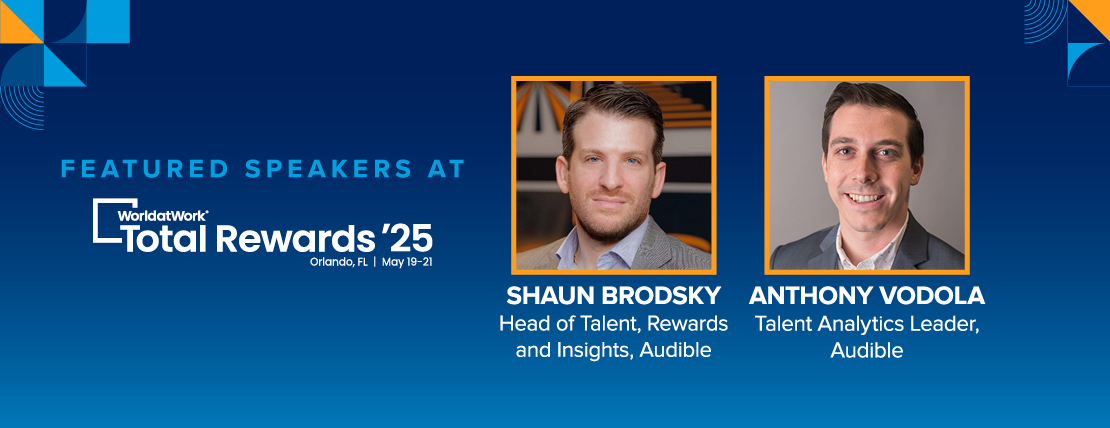For WorldatWork Members
- Setting Relevant Metrics: Key to Effective Performance Management, Journal of Total Rewards article
- Reimagining Rewards Strategies in the New Landscape of Work, Journal of Total Rewards article
- People Analytics Study, research
For Everyone
- Total Rewards ‘25, conference
- Elevate Engagement and Workforce Planning Through AI, Workspan Daily article
- How to Source and Analyze Data to Increase Business Insights and Impact, on-demand webcast
Shaun Brodsky and Anthony Vodola are no strangers to human capital transformations. Both are seasoned professionals with deep experiences in using analytics, collaboration and innovative strategies to position their organizations’ human resources (HR) and total rewards (TR) functions for whatever lies ahead.
Their latest transformation concept may be among their most intriguing, as they have led organizational efforts to:
- Examine the talent and business landscape.
- Adjust how human capital is viewed and quantified.
- Make substantive strategic adjustments, leading to more informed decisions about talent acquisition, development, retention and rewards differentiation.
Brodsky, the head of talent, rewards and insights at Audible (a provider and developer of online audiobook and podcast services), and Vodola, a talent analytics lead at the company, will outline their novel strategy in a session titled “ELITE: Transforming HR Through Employee Lifetime Impact & Talent Economics” at WorldatWork’s Total Rewards ’25 conference, May 19-21 in Orlando, Fla.
Workspan Daily Editor Paul Arnold recently connected with these industry leaders to learn more about their transformative approach.
Check out other Workspan Daily articles from Total Rewards ’25:
- Might a Sales Mindset Be Your Key to Total Rewards Success?
- The Monumental Mission of Meaningful Mentorships
- Proactive TR Pros See ‘Train’ of Change Coming, Take Steps to Act
- The Keys to Creativity and Driving Innovative Total Rewards
- The Pros and Cons of Giving Managers Discretion on Merit Increases
- How An Industry Leader Sees Technology Transforming Total Rewards
- Biopharma Compensation Leader Has Put AI Under the Microscope
- Boldyn Networks Offers a Bolder Approach to Employee Well-Being
Arnold: Why is now the right time to transform HR, including the TR function? What’s the burning platform generating the need for change?
Brodsky: The HR landscape is evolving rapidly, and organizations need to keep up. Traditional HR metrics aren’t cutting it anymore. We need new frameworks that capture and maximize the value of our employment relationships. It’s about moving from subjective assessments to strategic, evidence-based talent management.
There’s also increasing pressure to optimize resources and get the best return on compensation investments. Companies need to ensure their labor costs align with the value they’re getting, especially when they’re being asked to do more with the same or the same with less.
The talent management landscape has become incredibly complex and there’s a growing need to demonstrate the return on investment (ROI) of HR initiatives. We need clear methods to quantify the business impact of our activities — everything from the cost of unfilled positions to the effectiveness of our retention and development programs.
Perhaps most importantly, HR needs to align talent strategies more closely with business objectives. Employee performance directly impacts business success, so we need frameworks that help prioritize HR initiatives based on their potential business impact.
Arnold: Given all the demands on — and challenges for — HR/TR leaders, what do you see as a potential path forward?
Brodsky: New problems require new solutions, so the path forward for HR and total rewards involves getting creative and borrowing ideas from other disciplines. For instance, one approach we’ve developed, which we call ELITE (Employee Lifetime Impact & Talent Economics), is a framework that combines principles from wildly different fields.
We borrowed some ideas from the customer lifetime value (CLTV) methodology, which helps businesses understand the total value of a customer over the entire relationship. We might use this to measure how an employee’s performance impacts the organization over time, from hire to departure.
We’ve also drawn inspiration from sports analytics, specifically the “wins above replacement” (WAR) statistic used in professional baseball. We can evaluate an employee’s contribution relative to a hypothetical replacement-level employee. This helps quantify the incremental value each employee brings to the organization beyond baseline expectations.
HR and TR practitioners should think differently about how we can quantify the ROI of our work by translating workforce metrics into financial terms that resonate with business leaders.
Arnold: How might an organization implement this type of framework within its HR/TR operations? What’s all involved?
Vodola: Implementing a new framework within HR/TR operations isn’t easy, but with the right level of change management and communications, it could be a game-changer for organizations looking to make data-informed talent decisions. At WorldatWork’s Total Rewards ’25, Shaun and I will share in depth how any organization can create a flexible framework for their workforce; but very generally, here’s how it might take shape in four steps:
- Start by identifying your most burning talent questions. What are your pain points? What does your company value in a workforce? What area of the lifecycle needs your attention — for instance, hiring, development, attrition?
- Create analytics tools that empower both HR professionals and business leaders to address those areas. For instance, a performance impact analysis could provide insights into the business impact of employee performance, which would not only help identify candidates for specific talent activities but also assist in prioritizing these activities based on potential impact.
- Craft the framework to quantify performance such that it’s anchored to financial measures. Translating productivity into monetary terms facilitates meaningful dialogue between your team and the business by presenting talent outcomes in familiar business language.
- Use those financial measures to make more informed decisions about resource allocation and program investments. This allows you to assess the ROI of both existing and proposed initiatives by understanding their effectiveness in attracting and retaining high-performing talent.
Arnold: What are the potential returns from implementing such a framework, and what additional outcomes could be anticipated down the road?
Vodola: Implementing a new framework is a journey, but organizations could potentially see several meaningful results early on, with more significant impacts as it matures. The immediate benefits can be having a common language for talent analytics, new metrics that address your specific burning questions and models that tell your unique talent stories.
And, by operationalizing performance, you set yourself up to translate productivity into financial terms and have more meaningful conversations. For example, by demonstrating the value unlocked by reducing time-to-fill, recruiting leadership could make more informed decisions about preferred interventions, like determining if it’s more cost-effective to hire additional resources or implement new technology.
Arnold: What advice could you provide for those interested in exploring this concept further or even test-piloting something like this within their operations?
Vodola: We recommend starting with a focused approach rather than attempting full-scale implementation. The initial action steps are about building the foundation while demonstrating quick wins.
Implementing a framework starts with refocusing your talent management goals. Every company has the same talent activities; we aren’t introducing something brand new to that list. Rather, we’d recommend developing a solution that has rigor but allows for creativity and flexibility.
To get started, you would need:
- An understanding of the business strategy, which informs your talent strategy and helps identify the talent needed to achieve business goals;
- A performance management process that reliably evaluates employee contributions; and,
- Your organization’s people-related values, which guide decision-making.
With those three things in place, you are likely ready to design your framework. It should have five main components:
- A common language for shared understanding across stakeholders;
- Guiding principles that shape your philosophical approach;
- Bespoke metrics that tell your unique talent story;
- Conceptual models to visualize complex relationships; and,
- Systematic decision points that trigger timely interventions based on your data.
Arnold: What internal and cross-functional players do you need to bring on this journey, and why?
Brodsky: Implementing a value-based talent framework is a team effort. You need to bring several key players on board to make it work.
First, within HR, you can start with your HR business partners, who need to become experts in using these new tools for strategic talent decisions. Your total rewards team is crucial for aligning compensation with performance and value generation. Talent acquisition will be pivotal in optimizing recruitment processes. And, of course, your HR analytics team is the backbone, maintaining the measurement systems and predictive models that power the framework.
But, it’s not just an HR show. You need to get leaders on board. They need to understand and support this framework as it impacts strategic decisions across the organization, and they need to grasp how performance metrics translate to business value.
Your finance team can become an essential partner, helping quantify HR initiatives in financial terms and validate ROI calculations, bridging the gap between talent metrics and business outcomes.
Last, and perhaps most important, are your employees and supervisors, who need to understand how their performance contributes to organizational value.
Arnold: What are some leading practices and lessons learned in transforming HR/TR functions?
Brodsky: In our experience, we’ve learned compensation isn’t the silver bullet we often think it is. Even competitive pay doesn’t guarantee retention. Understanding what truly motivates employees beyond money is crucial.
The core HR pillars haven’t changed much, but our approach has. Success comes from how we identify key talent segments, assess performance and potential, and act on data-driven insights. It’s about being proactive rather than reactive in talent management.
This proactive approach raises a critical question: Who do we actually want to retain? Not every departure is a loss, and not every retention effort delivers equal value. We’ve learned to focus on top talent and hard-to-fill roles that create disproportionate value. By implementing sophisticated analytics and forward-looking frameworks, we can address potential talent issues before they become critical. This strategy ensures we maximize ROI on HR investments.
Editor’s Note: Additional Content
For more information and resources related to this article, see the pages below, which offer quick access to all WorldatWork content on these topics:







